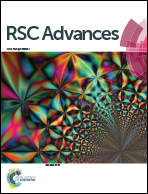Reduction chemical reaction synthesized scalable 3D porous silicon/carbon hybrid architectures as anode materials for lithium ion batteries with enhanced electrochemical performance†
Abstract
We report on a scalable fabrication of 3D interconnected porous silicon/carbon (Si/C) hybrid architectures via a controllable magnesiothermic reduction route from silica aerogels. The molten magnesium, as a reducing agent, can easily flow into the pores of silica aerogels, and reacts with the silica aerogels to form nanocrystalline Si. The Si nanocrystals can grow into Si nanosheets and assemble into 3D interconnected hierarchically porous Si architectures, due to the large negative enthalpies associated with magnesiothermic reduction. The pulverization and cracking effects caused by the large volume change during cycling and the unstable solid-electrolyte interphase can be greatly alleviated using the 3D porous hierarchical Si/C hybrid architectures as anode materials for lithium ion batteries (LIBs). The 3D porous Si/C hybrid architectures exhibit significantly improved electrochemical performance of high reversible capacity, high-rate capability, and excellent cycling performance as anode electrode materials for LIBs. The 3D porous Si/C hybrids display an improved electrochemical performance as anodes for LIBs, showing an excellent reversible capacity of 1552 mA h g−1 and a Coulombic efficiency of nearly 100% after 200 cycles at a current density of 200 mA g−1, and demonstrating a greatly enhanced rate capability with a reversible capacity of 1057 mA h g−1 even after 50 cycles at a current density of 2.0 A g−1. The outstanding cycling performance and rate capability of the 3D porous hierarchical Si/C hybrid anodes can be attributed to the advantages of a 3D interconnected porous structure, the carbon layer volume buffering effect, and the good carbon conductive network.


 Please wait while we load your content...
Please wait while we load your content...